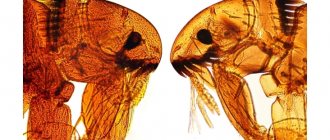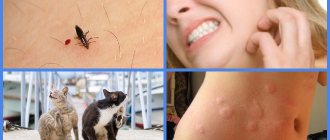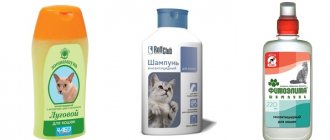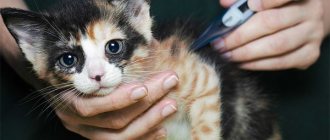The cat flea is a fairly common parasite that almost all cat owners encounter. Moreover, the appearance of a parasitic insect is possible both in pets who often come into contact with other animals and spend a long time on the street, and in those who spend most of their time in the apartment. Also quite often the subject of discussion is the issue of parasitism of cat fleas on humans and the associated risks. Why are cat fleas dangerous for pets and humans? How to detect fleas on pets in time and get rid of them?
Cat flea: how to get rid of it?
Cat flea: insect lifestyle
Appearance of an insect
The cat flea (Latin name Ctenocephalides felis) is a ubiquitous blood-sucking insect. The body length of an adult insect varies widely - from 0.7 to 5 mm. The body is dark, often black, somewhat flattened laterally and covered with numerous small setae. The hind legs of the insect are jumping, allowing it to jump up to 30 cm. Adults are dimorphic, that is, they are divided according to gender into males and females. The mouthparts are piercing-sucking, as adults feed on blood. The cat flea is somewhat different from the dog flea, primarily in its smaller size and head structure, but these differences can only be accurately determined using a microscope.
Cat flea under a microscope
Habitat of cat fleas
It is a common misconception that fleas, parasitizing, spend all their time on the “host”, but this is not the case. The natural habitat of fleas is places with a lot of garbage, animal nests, shelters under stones and in dry grass. In the house, fleas live under carpets, pet bedding, and baseboards. Often the places where fleas are most concentrated are the basements of multi-storey buildings, where the temperature remains above zero even in winter.
Nutrition
Having become hungry, the insect looks for a victim, and when a warm-blooded animal appears within reach - the flea orients itself using vision and smell - it jumps on it and satiates itself, making several bites. Having satisfied its hunger, the parasite returns to its permanent habitat.
A cat flea can starve for quite a long time, but the female needs blood to reproduce. If she fails to find a host in time, the eggs stop developing.
When hungry, the insect looks for a victim, then jumps on it and gets fed
On a note! A female cat flea, engorged with blood before laying eggs, can reach a length of 15 mm.
Reproduction
Females that have reached sexual maturity, after the eggs have matured, literally shoot them out of their habitats, thereby providing different conditions for the larvae, which hatch from the eggs within 2 to 14 days. Flea eggs are very small - approximately 0.5 mm in length, so they can be detected with the naked eye only in places where they are highly concentrated.
The hatched larvae have a worm-like body up to 0.5 mm, consisting of 13 segments. They feed on all kinds of organic remains - excrement of adults, particles of their host's litter, pieces of keratinized epithelium. The development cycle of the larvae largely depends on the ambient temperature and, under different conditions, can range from 9 days to 8 months before pupation.
Life cycle of a flea
Flea pupae are extremely hardy and can withstand unfavorable conditions for up to a year, including even low sub-zero temperatures. However, at high temperatures, an adult can develop from a pupa within a week.
On a note! The lifespan of an adult insect is from 3 months to three years. At above-zero temperatures, fleas are active all year round, and in ideal conditions, the full development cycle can take place in 15 days.
Facts about fleas in cats and kittens. Where and how fleas live.
There are 2086 species of fleas on our planet, grouped into 15 families. But we are interested in fleas that live on cats and other domestic animals - the family Pulicidae or common fleas. We find fleas of this particular family on domestic cats and other pets: dogs, rabbits, ferrets, rats, hamsters and parrots.
Fleas bite only warm-blooded animals, as well as birds.
What does a flea look like on a cat, its distinctive features from other blood-sucking parasites:
- The narrow body, flattened on the sides, looks as if crushed.
- Small spines and bristles throughout the body serve for convenient movement in the fur.
- Elongated hind legs are a characteristic feature of fleas. Thanks to them, fleas can jump further than other insects.
- The size of an adult individual is from 1 to 5 mm; neither ticks nor bedbugs have such small sizes. Flea larvae are the same length, but they look completely different.
- The color of fleas that live on cats and other pets is brown; for example, earthen fleas are dark brown, almost black.
Below you can see cat fleas in the photo and understand what they look like:
Fleas do not have a piercing proboscis like other bloodsuckers; they cut through the skin of a cat or kitten with their jaws and plunge their body into the wound, as shown in the picture on the right.
An enzyme contained in flea saliva prevents blood clotting and causes severe itching in the cat.
Therefore, you can often see wounds, scratches and other sores on the body of a cat or kitten.
Scratching and wounds on a cat's skin should alert you; frequent scratching and licking are one of the signs that a cat has fleas. In addition to scratching, direct traces of parasites can be found on the cat’s body - flea excrement. You can see what feces and dirt from fleas look like in the photo:
Flea excrement on cats is digested blood, it serves as food for flea larvae, and when wet it becomes reddish in color.
Fleas do not camouflage or hide in a cat’s fur, so they can be easily detected; fleas are especially noticeable on cats with light hair; on black cats it is more difficult to identify fleas. Favorite places for fleas on a cat are the withers, as well as the base of the ears and tail. Due to their structure, fleas are almost invulnerable when trying to comb them out, gnaw them out or crush them with your fingers. A person can kill a flea only by crushing it with a fingernail on a hard surface, and this is very difficult to do, so fleas do not need to hide.
In the Middle Ages, ladies and gentlemen resorted to various tricks to fight fleas: there were special sticks - combs for high hairstyles and medallions for catching fleas. Even silk underwear and petticoats came into use, not least because fleas slipped off silk.
Where do fleas live?
Fleas prefer to settle and breed on animals that are attached to one habitat; domestic cats and kittens fit this criterion perfectly. Fleas do not live permanently on a cat, but only jump on it to drink blood or lay eggs. So, having had enough, after some time, the fleas leave the cat. Thus, fleas always have food at their fingertips.
The flea spends 95% of its time in the environment and only 5% on the cat.
In residential buildings and apartments, fleas live in crevices and small cracks in the floor, under baseboards, in bedspreads and carpets, in dusty places where the human hand rarely reaches during cleaning, as well as on cat bedding.
Fleas bite a cat every day, but if necessary, they can go hungry for a week to a month. If environmental conditions are not favorable for reproduction, then fleas can live without a cat, sealed in a cocoon for up to two years.
Thus, fleas can live quite a long time without a cat or a person, but they will not be able to reproduce, because for this they need blood.
Fleas can change their hosts, which makes these parasites potential carriers of various diseases. Humans are a suitable victim for fleas, so cat owners are at risk, because fleas carry more than 200 diseases dangerous to humans, so flea bites are scary not only because of the itching.
Many owners of hairless cat breeds assume that since there is no hair, there cannot be fleas, but this is not true. After all, fleas do not live on cats, but only bite them. Treatment of Sphynx cats for fleas is the same as for all other cat breeds.
The lifespan of a flea under ideal laboratory conditions is 1.5 years, but in reality fleas live with a cat for no more than two months.
Flea infestation of an animal
Because fleas are extremely resilient insects, a flea infestation in a pet can occur in almost any location suitable for flea habitation. The most common routes of infection are:
- When walking outside. In this case, contact with an infected animal is not at all necessary: the insect can be on a walking path, on a bench, or in the grass.
- A person who strokes an infected animal can become a carrier of fleas: the insects remain on clothing, not only adults, but also their larvae or eggs.
- Rodents are carriers of fleas. If your cat hunts, she can get fleas from them.
- From an adult animal to a kitten.
Fleas on a cat
In most cases, the cause of an animal's infection is very difficult to determine and exclude - it can happen at any time.
Methods for controlling fleas in cats
Blood-sucking parasitic insects are dangerous for both the pet and its owners, therefore, upon discovering an infestation, it is necessary to immediately take treatment measures. Fleas will have to be removed in several stages in order to destroy not only the adults, but also the larvae. Today, the pharmacological industry offers a huge selection of products for treating domestic cats against fleas and other ectoparasites.
If a cat has symptoms of ectoparasite infection, but the owners cannot identify the insects, it is worth taking the animal to the veterinarian. He will examine the pet, make a diagnosis and give recommendations for treatment.
The most common method of getting rid of fleas from a cat is to wash it with a special shampoo. As a rule, treatment products contain broad-spectrum insecticides that help cope with various types of ectoparasites.
Processing should be carried out several times. After the first wash, the adults will be destroyed. If the procedure is repeated, fleas hatched from the larvae. Repeated treatment must be done 10-12 days after the first. If necessary, you can treat the animal again.
Along with the use of an antiparasitic agent, other measures should be taken at the same time: treat surfaces in the house with insecticides, thoroughly wash the cat’s bed, and carry out a general wet cleaning.
In addition to shampoos, you can purchase other products at the pet store that help get rid of fleas in cats:
- mousses;
- sprays;
- powders;
- emulsions;
- drops;
- concentrated solutions in ampoules.
You need to treat your cat with such products carefully: in the direction from head to tail. After the procedure, you need to monitor your pet so that he does not start licking his fur. Antiparasitic agents contain poisonous substances - insecticides, which can be dangerous not only for insects, but also for the cat itself. Therefore, before use, you must carefully read the instructions and strictly follow them.
Apply the spray, mousse or other product first to your hand, and only then distribute it on the animal’s fur. A cat is not an indoor flower that can simply be sprayed with a spray bottle. When applying the product directly to an animal, there is a danger of it getting into the mucous membranes, eyes or ears. Therefore, you must act exclusively with your hands, trying to ensure that the mass gets only onto the fur and skin.
How to determine if a cat is infested with fleas?
Based on the appearance and behavior of the animal, the presence of parasites can be determined by the following primary signs:
- Nervousness and anxiety in the animal’s behavior and lack of normal sleep are noticeable.
- The animal’s appetite is disrupted: it may refuse the food it was accustomed to before.
- The cat itches and often bites itself, thus trying to get rid of annoying parasites.
- A close examination of the animal's undercoat reveals traces of flea excrement.
Traces of flea activity on a cat
What is the danger of infecting a pet with fleas?
As flea infestation progresses, it can have quite serious consequences for your pet:
- Severe exhaustion of the animal.
- The appearance of scratches covered with multiple flea bites.
- The formation of bald spots on the coat.
- Development of anemia in an animal.
- The appearance of allergic dermatitis.
- Lack of timely treatment can lead to the death of a pet.
Types of fleas
Attention! Flea infestation is especially dangerous for kittens - they develop anemia and exhaustion most quickly.
The danger of cat fleas to humans
Humans can also become victims of cat fleas. To do this, he does not have to have a cat at home, but most often cases of bites occur with pet owners. The main risk to humans comes not from direct flea bites, but from the fact that these insects are carriers of the following dangerous diseases:
- Brucellosis.
- Encephalitis.
- Plague.
- Hepatitis.
Flea bites on humans
However, the bites themselves are quite unpleasant: when piercing the skin in search of a capillary, the flea does not release any anesthetics, so the bite feels like a rather painful injection. After the insect has had enough and left a wound, a red areole remains in its place, and saliva can cause an allergic reaction. The bitten areas may be very itchy. As a rule, with multiple flea bites, they can be localized in one place. The bites are usually located at a distance of 1-2 cm from each other. There is slight swelling and redness at the site of the bite.
Can a domestic cat get fleas?
Cat owners living in apartment buildings do not think about whether a domestic cat can develop fleas . They are confident that their pets are safe. But the routes of infection by parasites are varied. Domestic cats may encounter them:
- At the veterinary clinic. There, in the reception room, there may be an infected animal, and this cannot be foreseen.
- At the entrance. Even if the cat jumps out of the apartment for a short time, this is enough for the fleas to cling to the fur.
- At exhibitions and competitions. A large concentration of animals in one room significantly increases the risk of infection.
- During transportation. Open carriers cannot protect an animal from accidental infection.
Fleas are highly fertile. One insect, falling on a cat’s fur, can lay up to 2000 eggs in it, 10-50 per clutch. The egg ripening period is up to 8 days. Not all eggs from the clutch will be able to hatch, but their number will be enough so that after 2-3 weeks there will be several dozen or even hundreds of adult fleas on the cat’s body.
Helping a person with flea bites
In order to remove unwanted itching, you can use the following remedies:
- Treat the bite sites with warm water and treat with any antiseptic - hydrogen peroxide, brilliant green, iodine.
- If the itching is significant, you can apply a saturated solution of baking soda.
- Apply ice to the bite area.
- To relieve an allergic reaction, take antihistamines - for example, Diazolin.
Flea bites must be treated, for example, with brilliant green
On a note! It is strictly forbidden to scratch flea bites, as this can lead to suppuration or infection. If you have a significant allergic reaction to stings, consult a doctor immediately.
How to rid a cat of fleas?
There are quite a lot of means to rid a cat of fleas, which are divided into the following types:
- Collars. Easy to use, suitable for those animals that do not like water procedures. There are models that can be used for kittens and also for pregnant cats without negative consequences. Provide effective protection when worn for up to one and a half months.
- Powders. Products that are more suitable for short-haired animals. They rarely cause allergic reactions, which makes them suitable for use on kittens.
- Sprays. Effective products with immediate action. Requires careful use - after applying the pet, you must put on a protective collar in order to protect the animal from getting the spray into the intestinal tract when licking.
- Shampoos. The most common products with a mild effect. Often used to prevent the appearance of parasites in animals.
- Drops on the withers. Easy-to-use products that are suitable for animals that have a panicky reaction to water.
- Pills. For greater effectiveness, these products are often used in combination with sprays or shampoos. They have a gentle effect on the animal.
- Injections. Effective products that are guaranteed to rid the animal of parasites, but injection requires a visit to the veterinarian.
| Product type | Name | Image | Description |
| Collars | Leopard | Domestic remedy for fleas and ticks. Validity up to 4 months | |
| Beaphar | Product based on morgosa extract. Does not cause allergic reactions. Can be used on kittens and pregnant cats | ||
| Bolfo | Effective German collar with a validity period of up to 4 months | ||
| Hartz | The product is made in multiple color options, including with a reflective effect. Pet protection period up to six months | ||
| Powders | Hartz | A drug based on karbofos that does not cause allergic reactions | |
| Puldis | Combined flea and tick repellent. Does not enter the bloodstream, accumulating in the epidermis, which eliminates allergic reactions | ||
| Sprays | Frontline | A drug with a validity period of up to 40 days. A 100 ml bottle lasts up to 2 years of use for one pet | |
| Hartz | A product that practically does not cause allergic reactions, which allows its use for kittens | ||
| Shampoos | Leopard | A domestic preparation with plant extracts - cloves, pelargonium and lavender. Can be used for kittens | |
| Celandine | A product containing permethrin with the addition of aloe and castor oil. Not suitable for pregnant cats and kittens | ||
| MS KISS | Product for long-haired pets with a convenient dispenser | ||
| Drops | Advocate | Medicine against fleas and worms. Not recommended for animals under one year of age | |
| Stronghold | Product made in the USA with the active ingredient selamectin | ||
| Inspector | Medicine for fleas, worms and ticks. Allowed for kittens over one and a half months old | ||
| Beaphar | Dutch preparation based on margose. Has low allergenicity levels | ||
| Pills | Comfortis | Beef-flavored tablets make them easy to use. Can be added directly to your cat's food. Duration of action up to 1 month | |
| Capstar | Fast-acting neurotoxin. Allowed for kittens from one month of age | ||
| Injections | Ivermectin | A product against ticks, fleas and lice. Used in combination with other products | |
| Eprimek | A product that has an anthelmintic and anti-flea effect |
Attention! Do not under any circumstances exceed the doses of medications indicated in the instructions, as this may lead to poisoning of the animal!
However, getting rid of fleas on an animal is not enough - you also need to observe the necessary prevention, for example, putting flea collars on your pet or using insecticides in smaller preventive doses.
Folk remedies for fleas in cats, cats and kittens
How to get rid of fleas in an apartment?
Fighting fleas when they appear in an apartment can present some difficulties due to the tenacity of these insects. Before you start treating the premises, you should make sure that the animal has been cured.
The following measures will help:
- Using insecticidal preparations, for example, “Raptor”, “Kombat”, “Executioner”, you should treat the floor and corners of the apartment. Also nowadays, concentrated products are common, from which you can independently prepare a solution for treating the room.
- Carefully treat rugs and the pet's sleeping area, as well as carpets - a favorite habitat for fleas, paying special attention to the animal's permanent resting places.
- If a large number of flea larvae and their eggs are found in any specific places, they should be re-disinfected.
- If possible, you should change your cat's bedding.
Video - How to get rid of fleas in a house or apartment quickly, effectively and safely?
Causes of fleas
Fleas in cats can appear completely unexpectedly for their owners. In this case, it does not matter at all whether the pet is walking on the street or not. Parasites can be brought into the house on clothes or with mud on shoes. They can even come into your apartment themselves through the threshold of the house or through the cracks in the ceilings. There are the following routes of entry for these insects:
- while walking in contact with an infected animal;
- through household items that have insect eggs and larvae on their surface;
- when adult insects are brought into the house on clothes or their larvae with dirt on shoes;
- from neighboring apartments where there are infected animals.
Do cat fleas bite people? A hungry flea attacks anyone who is nearby. There are no special restrictions in her diet, although she still prefers the blood of animals, and of a certain species. There is evidence that fleas attack people in the absence of their pets. Single bites can also be observed when the apartment is heavily infested with insects.
Fleas from cats are not transmitted to humans in the literal sense of the word. Insects only feed on animals and, accordingly, will not live on humans. However, they can migrate from place to place by jumping onto a person's clothing. This can happen if he walks near their habitat or pets an outdoor cat. Fleas can also move into the folds of clothing if a person picks up care items for an animal infested with insects.
Advice! To protect yourself from flea attacks, you need to carefully monitor the sanitary situation in your apartment - periodically wash the floor, wipe off dust, and wash dirty linen. It is in dust and piles of garbage that insects live and their larvae develop.
Preventing the appearance of fleas in the apartment
However, the fight against fleas is not limited to their one-time extermination. There is always the possibility of them getting into an apartment or house again. Also, in multi-storey buildings, warm basements are often the habitat of fleas. If there are a significant number of cat fleas in the basement, you should contact the sanitary and epidemiological station, otherwise the fight against them in the apartment may not bring any results.
To prevent the proliferation of fleas in an apartment, it is necessary to carry out thorough periodic cleaning of places where they may accumulate. Rugs and bedding also need to be washed periodically using insecticidal agents.
It is best to wear an anti-flea collar on your pet - this way the parasites will avoid the cat. Periodically, you should carefully examine the animal for the presence of fleas and, if they appear, immediately take measures to destroy them and disinfect the apartment. You should also be careful when coming into contact with other animals.
Domestic cats and fleas
Owners often wonder: fleas were found on a domestic cat, where did they come from? An animal that does not walk outside or approach infected cats is a potential victim of parasites. The fact is that fleas can be brought from the street by apartment residents on shoes. And if the apartment is on the ground floor, jumpers enter the house from the basement.
The owner should know that fleas always stay close to the source of food and warmth - that is, from the cat. But they do not live on the skin constantly, but get out from nearby shelters to feed on the blood of the animal. Where does a domestic cat get fleas? When bloodsuckers are not tormenting victims with bites, they hide under carpets, behind baseboards and under bedding. How do fleas reproduce in cats? The increase in the number of parasites has nothing to do with cats or people: fleas find a couple in shelters and immediately lay eggs, from which offspring soon appear.
What danger do fleas pose?
Cat fleas pose both a threat to the well-being of the animal and a danger to the health of its owners. If there are cat fleas, are parasites dangerous for humans or not? There is a clear answer to this question, namely:
- Itching and irritation of the pet's skin leads to emaciation and constant restlessness of the animal. By scratching the bite sites until they bleed, the cat allows pathogenic microbes to penetrate into the wounds, which leads to the appearance of ulcers. Fleas are carriers of dangerous viruses, which has been proven by scientists. Parasite bites provoke serious diseases such as salmonellosis and brucellosis. Bloodsuckers can infect a pet with worms: fleas are hosts to dozens of varieties of helminths. If a cat manages to catch and swallow a flea, he will most likely suffer from worms in the near future.
For the above reasons, flea bites are also dangerous for humans: the parasites carry plague, anthrax and encephalitis. If cats have fleas, are these parasites transmitted to humans?
Fleas drink the blood of both animals and humans, so eliminating these dangerous insects is the first priority of every owner of an infected pet.
How to check for fleas?
It’s easy to verify the presence of bloodsuckers: just push the animal’s fur to the sides and inspect the skin. If the suspicions are true, you should immediately begin treating the animal, preventing the proliferation of parasites. If suspicions are not confirmed, but the cat is itching and there are no fleas, it is necessary to examine the animal for the presence of subcutaneous ticks.
If cats have fleas, the symptoms of infection are as follows:
- restless behavior of the cat associated with attempts to catch a flea on its own body; red dots on the skin; bloodsucker feces on the animal's bedding in the form of tiny black dots.










